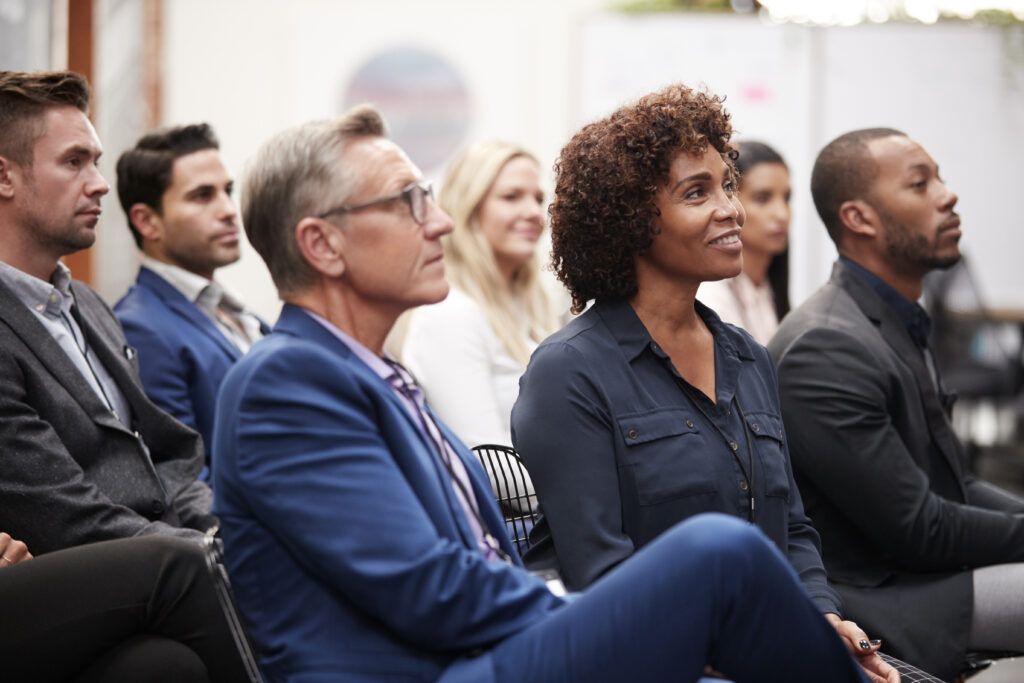How to Create a Conference Agenda:
A Step-by-Step Guide
You’ve got the venue sorted, some great keynote speakers lined up, and the best catering your town has to offer. Now it’s time to write your conference agenda to make sure your target audience knows all about it.
It doesn’t matter whether you’re hosting a massive in-person event across a multi-room venue or small virtual conference where everyone’s in the same conference call, it’s super important to have an agenda.
As well as setting expectations for your attendees, an effective agenda will also make sure there’s time to cover all key topics and activities. It also helps to organise the flow of the event, so everyone knows what’s happening (and when and where).
There’s so much information: where do you start?
We’re here to help. By the end of this article you should have a better understanding of what a conference agenda is (and why it’s important), how to format it, and the seven essential pieces of information that will form the basis for the structure.
Ready? Let’s go.
What is the purpose of a conference?
Before we dive into the what’s and whys of conference agendas, there’s a vital question to answer – why should we hold a conference in the first place?
Conferences serve as vital hubs for knowledge exchange, networking, and professional development within specific industries or fields. While the format and focus can vary significantly, the fundamental purpose of a conference generally revolves around several key objectives:
- Knowledge Sharing and Learning Opportunities:
Conferences provide a platform for business leaders, experts, researchers, and practitioners to share their latest business updates, recent findings, insights, and best practices. Attendees, on the other hand, benefit from gaining access to cutting-edge information and have the opportunity to learn from leading figures in their field.
- Networking and Connection Building:
Conferences offer invaluable opportunities to connect with peers, potential collaborators, and industry leaders. It’s a great way to build connections in teams large and small. These connections can lead to new partnerships, career opportunities, and a stronger sense of community.
- Professional Development:
Many conferences offer workshops, training sessions, and continuing education credits, allowing your attendees to enhance their skills and knowledge. Attending conferences can help professionals stay up-to-date with industry trends and advancements.

- Industry Advancement and Innovation:
Conferences can serve as catalysts for innovation by bringing together diverse perspectives and fostering discussions about emerging challenges and opportunities.
They can also provide a platform for showcasing new products, technologies, and research findings.
- Community Building and Engagement:
Conferences can reinforce a sense of belonging within a profession, and create a shared space for people with similar interests. They provide a space to build relationships and strengthen existing ones.
In essence, a conference is designed to create a dynamic and engaging environment where attendees can learn, connect, and contribute to the advancement of their field.
The conference agenda is the roadmap that guides attendees through this experience, ensuring that the event effectively achieves its purpose.
If you’re looking to put on a show-stopping conference, check out our article on ‘how to plan a conference’ today!
What is the purpose of a conference agenda
“What time is the keynote speaker on?”
“Where are the networking sessions being held?”
“When’s lunch?”
These are just a few of the questions running through your conference attendees’ minds. The purpose of a conference agenda is to answer those questions as quickly as possible.
Think of it as your event schedule, telling everyone where they need to be and when.
Without an agenda, your delegates might miss out on important panel discussions, keynote speakers or networking sessions. Being unable to plan their day properly will leave them feeling frustrated and confused – not the sort of memorable experience you’re hoping to provide.
Armed with a conference schedule, however, they’ll be able to identify the types of sessions they want to attend and give themselves ample time to reach the right place.
By making the attendee experience smoother, you’ll be on your way to a successful event.

How to Format a Conference Agenda
You’ll have all of the information you need as part of the conference planning process. Now it’s time to sit down and slot it into one handy document.
Start with the important information
The key details that your conference attendees need right away should be right at the top. For example:
- Event Name
- Date(s): for multi-day conferences, include the full range. You don’t want people leaving early!
- Location: As well as the venue and its address, also include information on the rooms or buildings you’ll be using
- Contact Information: include a contact email, phone number, website or social link where attendees can offer feedback or ask for help.

Add an itinerary with clear time slots
Break the day down into time blocks, allocating one to each activity or session. This way, people can see exactly when key events and talks are happening.
Here are a few tips on how to keep the schedule as easy to follow as possible for your attendees:
- Be Consistent: If you start off using 24 hour time, don’t switch to 12 hour time halfway through. Pick a format (e.g. 13:00-14:00 or 1pm-2pm) and stick to it
- Build in Buffer Time:Try to leave 10-15 minutes between time slots to give people ample time to change room, or to account for speakers going over.
- Make Important Events Stand Out: For super important sessions like keynote speakers, use bold or a larger font. Use this sparingly – once or twice per day is enough.
- Include Descriptions: Make sure people have all the information they need about the session concept, speaker and location. Bullet points are handy here!
Think about how attendees are going to access it
Will the agenda be shown on a conference app? Will it be printed as a glossy booklet, or simply on an A4 sheet of paper? The way you decide to present the agenda to your target audience will have a big influence on how you design it.
Add some visual elements
Adding some graphics (like logos), printing the agenda in your brand’s colours, or adding photographs of keynote speakers can really bring your conference programme to life.
The 7 Information Items That Must Appear On A Conference Agenda
No matter what your event is about, how big or small it is, these bits of information will form the backbone of your conference schedule.
1. Date and time
Include the overall start and end times, and dates if it’s a multi-day conference. This sets expectations for attendees.
If there are open-ended networking opportunities at the end of the day, indicate that the night can go on for as long as attendees want:
For example, ‘5pm onwards: networking drinks’
Include specific time slots for each session. Again, this will help to set expectations and help attendees to manage their time. If they know that the keynote speech is going to last for 90 minutes, they’ll be able to nip to the loo beforehand. If it’s a quick 15-min session, they might be happy to cross their legs and wait.
2. Session titles
Use straight-to-the-point titles for each talk, workshop or panel discussion. You want your attendees to be as excited about each session as possible, so it’s important that the theme of each agenda item is as clear as possible.
3. Speakers and presenters
List the names of guest speakers, their titles, and any affiliations or companies they represent. This will help to drum up excitement and encourage attendance at events.

4. Session descriptions
If you have space, include a one-sentence ‘elevator pitch’ elaborating on what each session is about.
For larger conferences covering a range of themes, consider including a label so attendees know if it’s relevant to their interests (for example ‘marketing’, ‘tech’, or ‘leadership’).
This will help your delegates to plan which sessions they want to go to (and which ones they can skip if they have to).
5. Location information
As well as including the address, also add venue and room numbers: especially if you’re hosting a large conference with multiple tracks or breakout sessions.
For virtual conferences, include details about the software you’re using (Zoom? Teams? YouTube? Something else?) so people can download it in advance.
Make sure to include any access codes or passwords. You want to reduce the chance of tech errors as much as possible!
6. Time for breaks
Include breaks between sessions, as well as an hour for lunch and dedicated time for networking opportunities. It will help your audience to focus if they know when they’ll be able to grab a coffee or have a chat soon.
7. Contact or help information
Include a contact point (email, number) and instructions on where attendees can go for help or support during the event.
Top Tips For Building A Solid Conference Agenda
Whether you’re planning a complex event or a relatively simple one, you can set yourself up for success by following our expert tips.
Start planning early
Creating an agenda shouldn’t be a last-minute thing. Generally speaking, it’s more of a the-earlier-the-better kind of thing!
Once you’re aware of how many time slots there are, it will be easier to plan how many speakers you need (and how long they’re able to talk).
The earlier you do this, the easier it will be to shift things around and find backup speakers if necessary.
Be flexible!
Plan for contingencies, such as session delays or speaker cancellations. Build in buffer time for people to get from room to room and to account for sessions overrunning. Having some backup speakers in the wings will also help keep things running smoothly.
Gather feedback
Don’t be afraid to ask for input from potential attendees or stakeholders while planning the agenda.
After the event, send out a survey to find out what you did well and what you could do better. This will help you to plan the agenda of future events.

An awesome agenda is key to a successful conference
Your conference agenda isn’t just a handout for attendees. It’s also a key tool for conference planning. Outlining everything in a scannable itinerary ensures you’ve got enough time and space for all of your speakers, workshops and events.
Before packing your schedule to the brim, think about comfort breaks, opportunities for attendees to grab a coffee, and time for networking afterwards. You want people to have fun: it’s important to give people a great event experience!
The most important thing is ensuring your attendees have all the information they need. Make sure basic housekeeping stuff like the venue address and where to get help are clearly printed at the top, and include as much straight-to-the-point information about each session as possible to maximise attendance.
Let the experts handle it
Another option is letting us do it all for you. At Maximillion Events, we’ve got years of experience in conference planning. We can handle all the behind-the-scenes stuff to get your event ready to roll. We can do as much or as little as you need, including sourcing venues and speakers or just designing the stage and production.
To learn more about how we can help you put together the ultimate conference agenda, get in touch.



